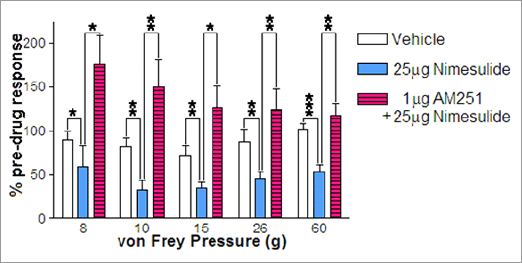115P Brighton
Winter Meeting December 2007 |
A role for endocannabinoids in NSAID-mediated analgesia?
Lydia Staniaszek1, David Kendall1, Palwinder Mander2, Victoria Chapman1
1University of Nottingham, Nottingham, United Kingdom, 2GlaxoSmithKline, Harlow, United Kingdom
The analgesic effects of endocannabinoids (EC) are mediated by cannabinoid receptors and are limited by metabolism by enzymes such as fatty acid amide hydrolase (FAAH) and monoacylglycerol lipase (MAGL). In addition, other enzymes such as cyclooxygenase-2 (COX-2), which has constitutive activity in some tissues, for example the spinal cord, may also metabolise ECs. The aim of this study was to investigate the effects of the COX-2 inhibitor nimesulide on evoked responses of spinal neurones in anaesthetised rats, and to determine the contribution of the cannabinoid CB1 receptor to these effects.
Extracellular recordings from laminae V and VI dorsal horn (DH) neurones were made in anaesthetised (1.5% isoflurane in 66% N20 / 33% O2) male Sprague Dawley rats (210-260g, Elmes et al., 2004). Effects of spinal administration of nimesulide (1-100μg/50μl) or vehicle (3% Tween80 in saline) on mechanically-evoked noxious (26 and 60g) and non-noxious (8, 10 and 15g) responses of DH neurones were studied. The ability of pre-administration (30 minutes prior) of the CB1 receptor antagonist AM251 (1μg/50μl) to modulate the effects of nimesulide (25μg) on responses of GH neurones was studied.

Figure 1. Effects of spinally administered nimesulide on mechanically-evoked responses of DH neurones (n=6). Data are mean ± SEM. Statistical analysis of effects of nimesulide plus AM251 used Mann-Whitney test *P<0.05, **P<0.01
Although there was a clear tendency for spinal administration of nimesulide to attenuate mechanically evoked responses of DH neurones in naïve rats (n=6 neurones in 6 rats, Fig 1), significance was not reached. Inhibitory effects of nimesulide were blocked by pre-administration of the CB1 receptor antagonist AM251 (Fig. 1).
These data support evidence (Ghilardi et al., 2004) that COX-2 is constitutively active in the spinal cord. The ability of AM251 to block the inhibitory effects of nimesulide suggests that these effects are mediated at least in part, by ECs acting via CB1 receptors, or via functional antagonism. Future studies will further investigate the role of COX-2 metabolism of ECs in the spinal cord under these conditions.
Elmes et al., (2004) Eur J Neurosci., 20(9):2311-2320
Ghilardi et al., (2004) J Neurosci., 24:2727-2732
|


